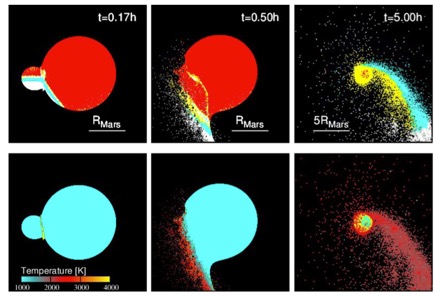Paper title: On the impact origin of Phobos and Deimos I: thermodynamic and physical aspects
Phobos and Deimos are the two small moons of Mars. Recent works have shown that they can accrete within an impact-generated disk. However, the detailed structure and initial thermodynamic properties of the disk are poorly understood. In this paper, we perform high-resolution SPH simulations of the Martian moon-forming giant impact that can also form the Borealis basin. This giant impact heats up the disk material (around ~2000 K in temperature) with an entropy increase of ~1500 J K−1 kg−1. Thus, the disk material should be mostly molten, though a tiny fraction of disk material (~5wt%) would even experience vaporization. Typically, a piece of molten disk material is estimated to be meter sized owing to the fragmentation regulated by their shear velocity and surface tension during the impact process. The disk materials initially have highly eccentric orbits (e ~ 0.6-0.9), and successive collisions between meter-sized fragments at high impact velocity (~1-5 km s−1) can grind them down to ~100 μm sized particles. On the other hand, a tiny amount of vaporized disk material condenses into ~0.1 μm sized grains. Thus, the building blocks of the Martian moons are expected to be a mixture of these different sized particles from meter-sized down to ~100 μm sized particles and ~0.1 μm sized grains. Our simulations also suggest that the building blocks of Phobos and Deimos contain both impactor and Martian materials (at least 35%), most of which come from the Martian mantle (50-150 km in depth; at least 50%). Our results will give useful information for planning a future sample return mission to Martian moons, such as JAXA's MMX (Martian Moons eXploration) mission.

| Journal: | Astrophysical Journal |
| Title of original paper | On the impact origin of Phobos and Deimos I: thermodynamic and physical aspects |
| Authors: | Ryuki Hyodo1,Hidenori Genda1,Sébastien Charnoz2,Pascal Rosenblatt3 |
| Affiliations |
1 Earth-Life Science Institute, Tokyo Institute of Technology, Japan |
| DOI | 10.3847/1538-4357/aa81c4 |
| Online published | 18 August, 2017 |
ELSI Researchers|Ryuki Hyodo, Hidenori Genda
